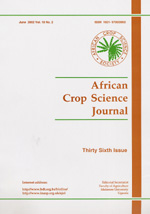
|
African Crop Science Journal
African Crop Science Society
ISSN: 1021-9730
EISSN: 1021-9730
Vol. 28, No. 3, 2020, pp. 449-472
|
 Bioline Code: cs20032
Bioline Code: cs20032
Full paper language: English
Document type: Research Article
Document available free of charge
|
|
|
African Crop Science Journal, Vol. 28, No. 3, 2020, pp. 449-472
| en |
Effect of self-pollination with heat-treated pollen on parthenocarpy and homozygosity in cassava
Buttibwa, M.; Kawuki, R.S.; Baguma, J.K.; Nalela, P.; Eyokia, M.; Oshaba, B.; Ceballos, H.; Lentini, Z.; Baguma, Y. & Tugume, A.K.
Abstract
Cassava’s ( Manihot esculenta

Crantz) high heterozygosity complicates its genetic improvement via selective breeding. Double haploid (DH) technology can be used to improve the crop’s heterozygosity, thereby improving the capacity for genetic improvement. The objective of this study was to evaluate the effect of self-pollination using heated pollen on pollen tube penetration, fruit set, seed and haploid embryo development in cassava genotypes for the production of haploid cassava. Pollen from two cassava genotypes, NASE3 and NASE14, was heated at 40, 50 and 60 oC for 0.5, 1.0 and 2.0 hr each. The heated pollen was used in six rounds of self-pollinations. Pollen tube penetration was monitored by fluorescent microscopy, followed by early embryo rescue and ovule culture. Ploidy and zygosity were assessed using flow cytometry and single-nucleotide polymorphism analysis, respectively. Pollen germinated on the stigma, grew within the style through the nucellar beak, but did not reach the embryo sac, thus achieving no fertilisation in all the 5756 self-pollinated flowers. There was a reduction in pollen germination ( in vitro and in vivo), pollen tube penetration and fruit set with increasing temperature. Heat-treated pollen stimulated division of the egg cell and induced development of parthenocarpic fruits. Up to 6 embryoids per ovule were observed and all regenerated plantlets were diploid, with up to 93.0% increased homozygosity. For the first time, plant regeneration from ovules, pollinated with fresh pollen at 14 days after pollination, was achieved indicating improved speed in plant regeneration. The data generated are important for the development of protocols for cassava DH plant production.
Keywords
Double haploids; embryo rescue; Manihot esculenta
|
| |
| fr |
Buttibwa, M.; Kawuki, R.S.; Baguma, J.K.; Nalela, P.; Eyokia, M.; Oshaba, B.; Ceballos, H.; Lentini, Z.; Baguma, Y. & Tugume, A.K.
Résumé
La forte hétérozygotie du manioc ( Manihot esculenta

Crantz) complique son amélioration génétique par sélection sélective. La technologie d‘ haploïde double (DH) peut être utilisée pour améliorer l’hétérozygotie de la culture, améliorant ainsi la capacité d’amélioration génétique. L’objectif de cette étude était d’évaluer l’effet de l’auto-pollinisation à l’aide de pollen chauffé sur la pénétration du tube pollinique, la nouaison, le développement des graines et des embryons haploïdes dans les génotypes de manioc pour la production de manioc haploïde. Le pollen de deux génotypes de manioc, NASE3 et NASE14, a été chauffé à 40, 50 et 60 oC pendant 0,5, 1,0 et 2,0 heure (s) chacun. Le pollen chauffé a été utilisé dans six cycles d’auto-pollinisation. La pénétration du tube pollinique a été surveillée par microscopie fluorescente, suivie d’un sauvetage précoce des embryons et d’une culture d’ovules. La ploïdie et la zygosité ont été évaluées à l’aide de la cytométrie en flux et de l’analyse du polymorphisme mononucléotidique, respectivement. Le pollen a germé sur le stigmate, s’est développé dans le style à travers le bec nucellaire, mais n’a pas atteint le sac embryonnaire, n’obtenant ainsi aucune fécondation dans toutes les 5756 fleurs autogames. Il y avait une réduction de la germination du pollen ( in vitro et in vivo), de la pénétration du tube pollinique et de la nouaison avec l’augmentation de la température. Le pollen traité thermiquement a stimulé la division de l’ovule et induit le développement de fruits parthénocarpiques. Les 6 embryoïdes par ovule ont été observés et toutes les plantules régénérées étaient diploïdes, avec 93,0% d‘augmentation d’homozygotie. Pour la première fois, la régénération des plantes à partir des ovules, pollinisées avec du pollen frais 14 jours après la pollinisation, a été réalisée, indiquant une vitesse améliorée de régénération des plantes. Les données générées sont importantes pour l’élaboration de protocoles de production de plantes de manioc de DH.
Mots Clés
haploïdes doubles; sauvetage d’embryons; Manihot esculenta
|
| |
© Copyright 2020 - African Crop Science Society
|
|
